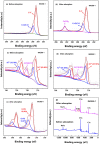Hexavalent chromium elimination from wastewater by integrated micro-electrolysis composites synthesized from red mud and rice straw via a facile one-pot method
- PMID: 35987789
- PMCID: PMC9392804
- DOI: 10.1038/s41598-022-18598-7
Hexavalent chromium elimination from wastewater by integrated micro-electrolysis composites synthesized from red mud and rice straw via a facile one-pot method
Abstract
The widely spread chromium (Cr) contamination is rising environmental concerns, while the reutilization of agro-industrial by-products are also urgently demanded due to their potential risks. In this study, we prepared the integrated micro-electrolysis composites (IMC) through a facile one-pot method with red mud and rice straw. The effects of components relatively mass ratios as well as pyrolysis temperature were analyzed. The XRD, XPS, SEM, FTIR, and various techniques proved the IMC was successfully synthesized, which was also used to analyze the reaction mechanisms. In this study, the dosage of IMC, pH, adsorption time, and temperature of adsorption processes were explored, in the adsorption experiment of Cr(VI), dosage of IMC was 2 g/L (pH 6, 25 °C, and 200 rpm) for isothermal, while the concentration and contact time were also varied. According to the batch experiments, IMC exhibited acceptable removal capacity (190.6 mg/g) on Cr(VI) and the efficiency reached 97.74%. The removal mechanisms of adsorbed Cr(VI) were mainly elaborated as chemical reduction, complexation, co-precipitation, and physical adherence. All these results shed light on the facile preparation and agro-industrial by-products recycled as engineering materials for the heavy metals decontamination in wastewater.
© 2022. The Author(s).
Conflict of interest statement
The authors declare no competing interests.
Figures







Similar articles
-
Preparation and Cr(VI) removal performance of corncob activated carbon.Environ Sci Pollut Res Int. 2018 Jul;25(21):20743-20755. doi: 10.1007/s11356-018-2026-y. Epub 2018 May 12. Environ Sci Pollut Res Int. 2018. PMID: 29754303
-
Adsorptive performance of activated carbon reused from household drinking water filter for hexavalent chromium-contaminated water.J Environ Manage. 2020 Oct 15;272:111085. doi: 10.1016/j.jenvman.2020.111085. Epub 2020 Jul 24. J Environ Manage. 2020. PMID: 32854889
-
Optimization of factors affecting hexavalent chromium removal from simulated electroplating wastewater by synthesized magnetite nanoparticles.Environ Monit Assess. 2015 Jan;187(1):4165. doi: 10.1007/s10661-014-4165-z. Epub 2014 Dec 4. Environ Monit Assess. 2015. PMID: 25471623
-
Kinetic and isotherms modeling of methyl orange and chromium (VI) onto hexagonal ZnO microstructures as a membrane for environmental remediation of wastewater.Chemosphere. 2022 Dec;309(Pt 2):136681. doi: 10.1016/j.chemosphere.2022.136681. Epub 2022 Oct 1. Chemosphere. 2022. PMID: 36195126
-
Enhancing chromium removal and recovery from industrial wastewater using sustainable and efficient nanomaterial: A review.Ecotoxicol Environ Saf. 2023 Sep 15;263:115231. doi: 10.1016/j.ecoenv.2023.115231. Epub 2023 Jul 8. Ecotoxicol Environ Saf. 2023. PMID: 37429088 Review.
Cited by
-
Enhanced Adsorptivity of Hexavalent Chromium in Aqueous Solutions Using CTS@nZVI Modified Wheat Straw-Derived Porous Carbon.Nanomaterials (Basel). 2024 Jun 3;14(11):973. doi: 10.3390/nano14110973. Nanomaterials (Basel). 2024. PMID: 38869598 Free PMC article.
-
Selenite elimination via zero-valent iron modified biochar synthesized from tobacco straw and copper slag: Mechanisms and agro-industrial practicality.Front Bioeng Biotechnol. 2022 Nov 14;10:1054801. doi: 10.3389/fbioe.2022.1054801. eCollection 2022. Front Bioeng Biotechnol. 2022. PMID: 36452212 Free PMC article.
-
A Comprehensive Review of the Current Progress of Chromium Removal Methods from Aqueous Solution.Toxics. 2023 Mar 8;11(3):252. doi: 10.3390/toxics11030252. Toxics. 2023. PMID: 36977017 Free PMC article. Review.
References
-
- Zhou X, et al. Tunable S doping from Co3O4 to Co9S8 for peroxymonosulfate activation: Distinguished Radical/Nonradical species and generation pathways. Appl. Catal. B. 2021;282:119605. doi: 10.1016/j.apcatb.2020.119605. - DOI
-
- Hong Y, et al. Efficient degradation of atrazine by CoMgAl layered double oxides catalyzed peroxymonosulfate: Optimization, degradation pathways and mechanism. Chem. Eng. J. 2019;370:354–363. doi: 10.1016/j.cej.2019.03.127. - DOI
Publication types
MeSH terms
Substances
LinkOut - more resources
Full Text Sources

